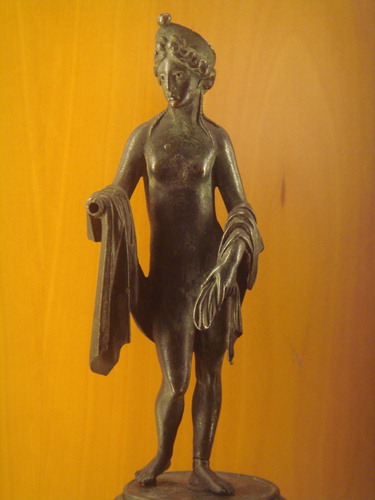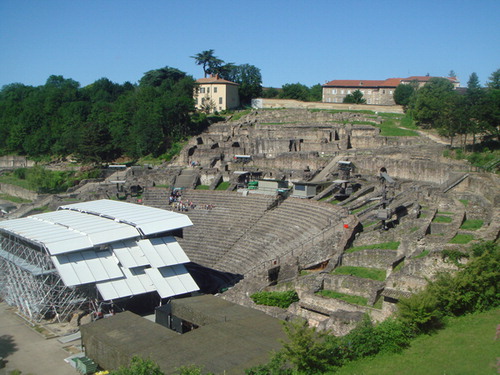The 26th International Conference on ‘Surface Modification Technologies’ (SMT26) was held in the École Centrale de Lyon between the 20th and the 22nd of June 2012. The organisers were Dr Vincent Fridrici of the Laboratory of Tribology and System Dynamics, École Centrale de Lyon together with the ‘historical’ organisers of SMT: Professor Michel Jeandin, École des Mines Paris and Dr T.S.Sudarshan, the Editor of Surface Engineering.
The 2012 meeting, as in Paris in 2000 (SMT14), in Dijon in 2005 (SMT19), and in Paris again in 2007 (SMT21), featured sessions on: thermal spray; wear and corrosion; biomedical coatings and surface treatments; biomimetic, biomaterials and bioprocesses; surface treatments; cold spray; surface characterisation; electrodeposition; tribology; laser; hydrophilicity; coatings; corrosion; nitriding as well as a session on arts and surfaces, organised by myself.
The arts and surface session has become a tradition and peculiarity of the SMT conferences held in France. I have had the opportunity of participating as invited speaker at SMT14 in Paris, and later the privilege of organising the arts and surfaces session in Dijon 2005 and in Paris 2007, and guest editing the subsequent special issue of Surface Engineering, which featured a selection of the best work presented during the session.
Lyon is the second largest urban area in France, a big town, but unlike many other European cities, it still has its own character. Walking around the centre the visitors feel the fascination of the past, with its architecture and old traditions. The Rhône and Saône rivers converge to the south of the historic city centre forming a peninsula. Vieux Lyon, the silk district around CroixRousse, and the Presqu'île are known for their picturesque narrow passageways called ‘traboules’. This area, together with the impressive Roman district and the Fourvière hill build up the Historical District of Lyon, an UNESCO World Heritage Site since 1998.
Lyon was founded by Munatius Plancus as a Roman colony in 43 BC on the Fourvière hill, where there was a Gaulish hill-fort settlement called Lug[o]dunon. The name means ‘the hill-fort of the Celtic god Lug’. The name of the old settlement was transformed by the Romans to Lugdunum. Very soon, because of its central position in the country and the privileged location on two rivers, the town became the capital of Gaul, the most important economic and political centre in the North-West of the Roman Empire and the starting point of the most important Roman roads in Gaul. Even two Roman emperors, Claudius and Caracalla, were born here. The opulent commercial and historical past of Lugdunum is still witnessed by the impressive Roman monuments, the two large Roman theaters (see photo n.1), and finally by the magnificent Gallo-Roman Museum on the Fourvière hill and the rich Museum of Fine Arts, both with large collections and abundant and exquisite finds from the Roman period (photo nr. 2), but also from later times.
In 461 AD, Lugdunum also became the capital of the new Burgundian kingdom: the Burgundian refugees from Worms (now in Germany) had been resettled here by Aetius, the military commander of the Western Roman Empire, after the destruction of their town by Attila and his Huns in 437.
In the late Middle Ages Lyon was considered the economic countinghouse of France because of its banks, and in the Renaissance its silk trade provided luxury fabrics, especially for the noble families of the Italian peninsula.
Figure 2. Roman statuette of the goddess Venus, 1st-2nd century AD, inv. n. A1902, Museum of Fine Arts Lyon. (photo A. Giumlia-Mair)

It is also important to mention that Lyon is now not only the capital of the smaller Rhône department, but also the main centre of French gastronomy (the universally known chef Paul Bocuse, inventor of the nouvelle cuisine, for which exclusively fresh ingredients of the highest quality are used, is also based in Lyon!). It is also the place of origin of famous wines, such as Beaujolais and Côte du Rhône. We had the opportunity to test Lyon's gastronomic fame during the delicious Social Dinner of the Conference in the Orangerie de Sébastien, in a chateau of the 16th century, surrounded by beautiful gardens, not far from the École Central.
This conference offered to the participants the occasion to get to know the copious and very varied historical, archaeological and artistic patrimony of the town, and the archaeological and historical attractions of Lyon made it the perfect frame for a session dedicated to the fascinating and intriguing topic of surface treatments, coatings, alterations and pigments in the field of art and archaeology. These topics are particularly complex, elusive and difficult to study and to discuss in ‘normal’ conferences dedicated to archaeology or art.
We have to keep in mind both sides of the problems involved with surfaces studies: the scientific issues, and the difficulties which always arise in studies of materials that cannot be easily sampled or cannot be sampled at all, and can be identified and characterised only by applying completely non-destructive techniques. For the right interpretation of the various techniques it is also extremely important to investigate and bear in mind the historical and cultural peculiarities of the different contexts from which the artifacts come. Without a deep knowledge of the material culture, the society and the belief of the period, it is impossible to reconstruct and determine the reasons and the meaning of particular surface treatments, coatings, choice of pigments etc. both in historical and prehistoric times.
Finds from archaeological sites always represent a challenge, because during their long burial periods their superficial structure has been altered, oxidised, encrusted or worse. Furthermore, it is not always possible to remove the damaged upper layers to investigate the material underneath. This means that at every find we are confronted with a new and different problem.
Surface studies are perhaps not yet well known, but they are a widely recognised field of research. The SMT meetings offer a suitable arena to present and discuss our very specialised studies. We can compare our results and disseminate our experiences, while, on the other side, having the possibility to listen to scholars presenting the last discoveries and methodologies developed in the scientific and engineering communities. In this way we can find out about the new advances in the related scientific fields, the new instruments, and perhaps discover new methods and techniques that could be applied to our materials. New approaches to solve some of our problems and perhaps even new collaborations could be the very beneficial results from this meeting.
At the SMT conference, almost an entire day was devoted to the arts and surfaces session. The program of the session consisted of ten oral contributions and four posters presented by scholars from several countries, and often by teams composed by authors from different countries. The plenary keynote was given by Professor Isabella Memmi Turbanti, Università di Siena, who presented an overview on coatings on ancient ceramics, discussing black gloss, transparent glazes, and enamel, and describing two special case studies. One concerned black gloss pottery from Etruria and the second the beautiful Sienese majolica and glazed ceramics from Southern Tuscany.
The first talk was given by Marc Aucouturier, CNRS Louvre, Paris, with an (invited) research carried out by his team on the technologies of leaf gilding, employed in the past and until our day. My own contribution, presented together with Professor Jeffrey Soles, North Carolina University, Greensboro, USA, also concerned gold. We presented a surprising and unexpected example of rose gold from Crete. This is a relatively unknown material, and was discovered in Egypt, in royal graves. However this particular ornament was found in a double grave dated to Mycenaean times in Mochlos, on the island of Crete. This amazing gold find was superficially treated exactly as the (very few known) examples found in Egypt. The faience beads found with it as elements of the same necklace, had also been produced with Egyptian technology, but the shape and the style of the necklace are Mycenaean or Aegaean.
Another paper on issues concerning gold was given by Amandine Crabbé who presented research performed by a Belgian/French team, on medieval treatments and ancient recipes for changing the colour of gold and silver. The session continued with a paper given by M. Aucouturier, on frescoes on lime and cement. Regrettably the authors could not write up the paper for this Surface Engineering issue.
We then moved to a different topic and material with a very interesting talk on the modification of natural shellac to improve its performance in treatments on wood. The authors were a team from the University of Pavia, Italy, and the paper was given by Dr M. Weththimuni. A second paper on wood concerned the study carried out by the team of the Pavia University on an unusual surface coating identified on a wooden bas-relief by Giacomo Bertesi, a 17th century artist from Cremona, Italy. The oral session was closed by a paper presented by Dr P. Barkóczy on the study carried out by the team at the University of Miskolc, Hungary, on the detailed microstructural investigation of a peculiar surface layer with a silvery colour, found on Bronze Age picks of Hajdusamson type.
The technology of the 7000 years old ceramic from Tappeh-Zaghe, in Iran, carried out by Prof. Emami, University of Isfahan, Iran, and Prof. Trettin, University of Siegen, Germany, was on schedule, as was also a research by Prof. Emami and Dr Bigham (both Isfahan), on a specific kind of corrosion due to inclusions in ancient bronzes, but regrettably, because of some problems with the visa of the Iranian colleagues, we had to skip the presentations. Luckily we have been able to rescue the two papers to publish them in this issue of Surface Engineering.
Among the poster presentations there was a very attractive study on the pigments employed for a 14th century painting by Bartolo di Fredi, a painter from Siena, that also won the first price offered by SMT26 for posters. A research on silvering techniques employed in a site discovered in the Atheneum of emperor Hadrian in Piazza Madonna di Loreto in Rome was illustrated in a poster by L. Anguilano, Brunel University, UK, while I also presented the reconstruction of the mechanism of development of black patina on artificially patinated copper-based alloys containing small amounts of precious metals, identified on Mycenaean objects, and similar to the modern Japanese alloy shakudo.
We hope that this special number of the journal Surface Engineering will be appreciated by our colleagues, as an effort to promote the integration of humanistic and scientific research, and as an attempt to develop a language understandable for both scholars working in the field of modern technology and in the field of art and archaeology. We hope our work will be considered a small step to advance the study of surfaces in art and archaeology and that it will help to improve the contacts between scholars working in humanities and in the scientific world.
Dr Alessandra Giumlia-Mair
AGM Archeoanalisi
I-39012 Merano (BZ) Italy
